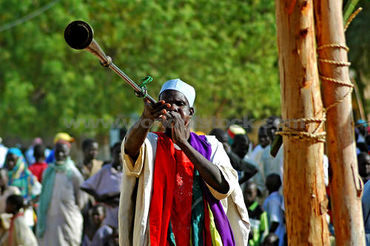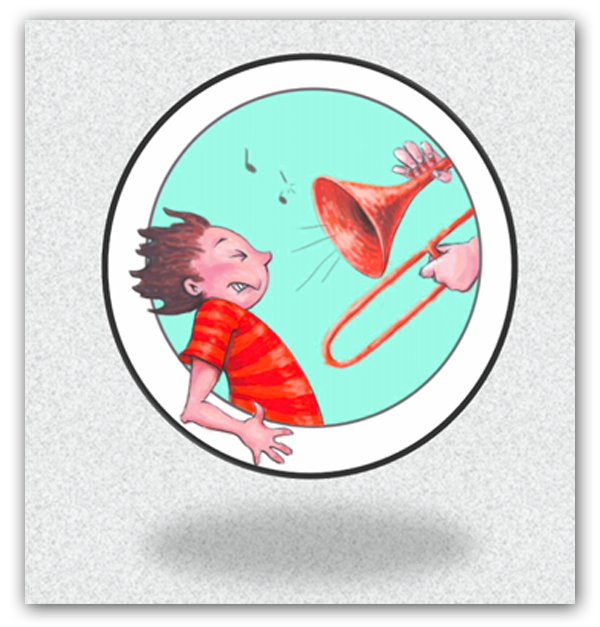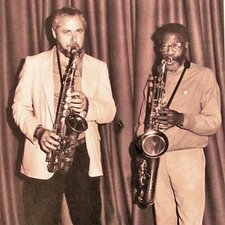Toot Your Own Horn Dept.:
A Self-Transcription of "Like Someone in Love"
 The Rev. Dizman Tootoot
The Rev. Dizman Tootoot
As I'd been checking this tune out lately (for about 30 years), I thought it would make good subject matter for a post, with a recorded solo example, as well as an audio file thereof; both downloadable.
Now ain't that generous?!
I think it's a very healthy thing, in terms of self-analysis, to record and transcribe one's self from time to time. The fact is, that if you don't happen to be one of the handful of "household (make that "practice room") names", you might as well transcribe yourself, for yourself.
Besides, "it's my blog and I'll toot if I want to"! Dig?!

My first encounter with the tune was upon hearing John Coltrane's haunting, super slow trio version from his Prestige album "Lush Life", which was among the first few jazz albums I owned. Being a novice at the time, the pianoless version was hard for me to decipher harmonically, but it was ever so beautiful and mysterious, and still is.
'Trane's version was in the key of Ab (concert), as were most of the other recorded instrumental versions of the tune that I had heard, although all the lead sheets and playalongs I found were in other keys.
As I've always thought of this tune as being in Ab (tenor key Bb) by default, I was happy to find an Ab playalong track for this little project at www.playjazznow.com. The track has a very straight ahead, relaxed, bouncy feel to it, inside harmonically and easy to play to. They might have chosen a more imaginitive ending, but hey.

Ab7 C/G | F- F-/Eb | Bb7/D Db7#11 | C-7 F7 |
as well as the deceptive bv - VII (D-7 G7) cadence in measure #6, resolving momentarily to the tonic (Ab Maj7) for a measure.
It then jumps up and ii-Vs (Eb-7 Ab7) to Db for a bar.
It just can't sit still, so it jumps up once more and ii-Vs itself (G-7 C7) to F, this time for 2 bars, before cycling back for 4 bars (F-7 | Bb7 | Bb-7 | Eb7) to the tonic Ab.
Pretty slick for 1944! Pretty slick for right now!
 Ol' King Toot - Retro Style
Ol' King Toot - Retro Style
It's kind of difficult to comment on my own playing, but I'll give it a shot.
OK, to be perfectly honest, I wouldn't be posting this if I didn't think the results were decent enough, right?
I've been playing on people's tracks for a lot of years now, so I have a pretty good instinct for style, that tends to click in automatically, depending on the situation.
Play-a-longs are a great way to practice and learn the basics of a tune, but past a certain point, they can become confining and can actually limit what you can do harmonically. One work around for that is to mute the channel with the piano and play with only bass & drums. I love playing that way, anyway, with a strong bass player especially.
You need to know the tune really well, and have the ability to both define and move outside / inside the harmonic format, in order to make that work.
With this particular track, unfortunately one is unable to mute the piano, as it is recorded in stereo. The Aebersold play-a-longs allow you do this, but for this particular tune, I specifically wanted to play it in Ab concert, and this track is in that key, and swings nicely to boot.
Cool!
One thing about this short solo, which lasts a chorus and a half, that I'm pleased with, is my use of false fingerings, both on the head and in the solo. Because the tenor key is Bb, I'm able to make effective use of the lower octave fingerings for middle range Bb, C, Db D & F, as well as alt fingerings for high C & D. I tend to move back and forth between the actual and alternate fingerings, creating a quasi "wah-wah" effect. Maybe, because I started out on bluesharp, I feel the need to do this. Maybe it's just oral gratification, I dunno.
I like the fact that I'm instinctively using space, especially after flurries of 16th notes, that allow the very together and well recorded rhythm section to come through.
I also like the fact that there's a pretty fair amount of rhythmical diversity in the solo; i.e., a mixture of swung eighth notes, sixteenth note groupings; a few quarter, eighth and sixteenth note triplets, thereby avoiding a flow of any one rhythmic division exclusively (constant streams of eighth or sixteenth notes, etc.).
Range-wise, it spans from tenor low Eb to altissimo Ab; so 2 1/2 octaves, for a chorus and a half. OK..
The only thing that bugs me a little bit is that the first two 16th note phrases (bar 6 and 9-11) feel a bit rushed to me, but maybe not terrible enough to do a Disney on it.
Harmonically, it's pretty straight up. Linear, for the most part, with a few Melodic Minor (altered scale) devices thrown in on most of the ii-V7s.
Anyway, I don't know how "killin'" it all is, but I think I sound like I was having fun; which I was.
I hope you do too!
Have yourself a good Toot de Jour!

 RSS Feed
RSS Feed








